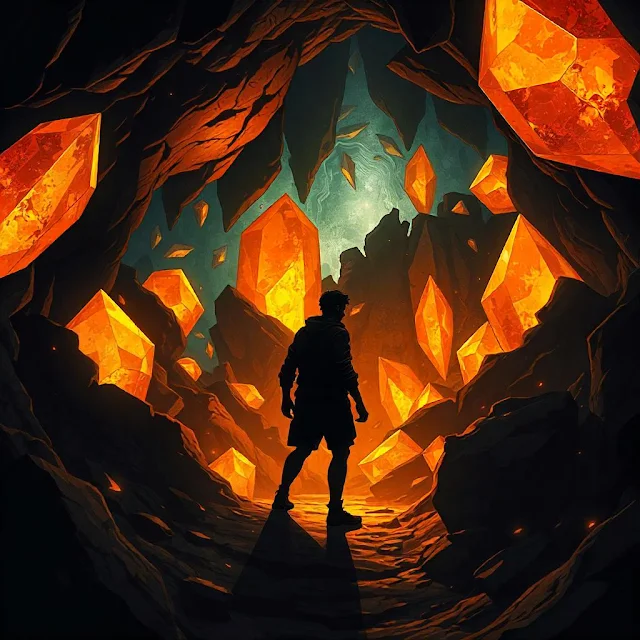The Magical Power of Gemstones: Between Myth and Reality
 |
| The Magical Power of Gemstones: Between Myth and Reality |
The Magical Power of Gemstones: Between Myth and Reality
Introduction
Gemstones, particularly agate stones (known as "batu akik" in Indonesian), have fascinated humans for centuries. They are not only admired for their beauty but also revered for their purported magical and healing properties. The belief in the powers of these stones transcends cultures and time, giving rise to various myths and practices. This article explores the rich tapestry of beliefs surrounding agate stones, examining their historical significance, cultural implications, and the intersection of myth and reality.
Historical Significance of Agate Stones
Ancient Origins
Agate stones have been used since ancient times. Archaeological evidence suggests that these stones were popular in ancient Mesopotamia, Egypt, and Greece. The earliest known use of agate dates back to 3000 BC, where it was carved into amulets and talismans believed to protect the wearer from harm.
Symbolism in Different Cultures
Mesopotamia: In ancient Mesopotamian culture, agate was associated with protection and power. It was often used in jewelry and engraved with symbols to invoke the favor of deities.
Egypt: The Egyptians believed agate had protective properties and used it in funerary contexts to ensure safe passage to the afterlife.
Greece and Rome: Greek philosophers, including Aristotle, noted the effects of gemstones on physical and emotional health. Romans believed agate could improve eloquence and communication skills.
The Spread of Agate in Asia
As trade routes expanded, agate made its way to Asia, particularly in India and Indonesia, where it took on new meanings. In these cultures, agate is often linked to spirituality and healing.
The Cultural Significance of Agate Stones
Indonesia's Love for Batu Akik
In Indonesia, the cultural significance of batu akik cannot be overstated. The stone gained immense popularity in the early 2000s, leading to a nationwide craze.
Traditional Beliefs
Indonesians believe that different types of agate possess unique powers. For instance, red agate is thought to enhance courage, while green agate is believed to attract prosperity. Many people wear these stones as a means of spiritual protection and personal empowerment.
Social Status
Owning and wearing specific types of batu akik can symbolize social status. The more rare and beautifully crafted the stone, the higher the prestige associated with it. This trend has given rise to a market where collectors often pay hefty sums for exquisite pieces.
Global Perspectives
Across the globe, agate has been attributed various properties:
Healing: Many cultures believe that agate can promote physical and emotional healing. Practitioners of crystal healing use agate to balance emotions and soothe the mind.
Spiritual Growth: In New Age practices, agate is considered a grounding stone, helping individuals connect with their inner selves and enhancing spiritual growth.
Protection: Agate is commonly viewed as a protective stone, guarding against negative energies and fostering a sense of security.
The Science Behind the Myths
Geological Properties of Agate
Agate is a form of chalcedony, composed primarily of silica. Its unique banded appearance is formed through the deposition of minerals in volcanic rock. While the geological properties of agate are fascinating, they do not inherently confer magical powers.
Psychological and Physiological Effects
Placebo Effect: Many individuals report positive changes when using gemstones for healing. This phenomenon may be attributed to the placebo effect, where belief in the efficacy of a treatment leads to real psychological and physiological improvements.
Mindfulness and Focus: The act of using stones for meditation can enhance mindfulness, helping individuals focus and reduce stress. This practice may explain some of the reported benefits associated with agate.
Scientific Scrutiny
Despite widespread beliefs, scientific studies have yet to conclusively prove the healing powers of gemstones. Research in this area often lacks rigor, with anecdotal evidence overshadowing empirical data.
The Intersection of Myth and Reality
The Role of Belief
Belief plays a significant role in the perceived effectiveness of agate. For many, the rituals associated with gemstones create a sense of empowerment and control over their lives. The interplay between belief and personal experience is complex, making it difficult to disentangle myth from reality.
The Market for Gemstones
The rise of the internet and social media has amplified the market for gemstones, particularly agate. Online forums and social media groups have fostered communities where enthusiasts share experiences, reinforcing beliefs in the stones’ powers.
Collecting Trends: The rise of gemstone collecting has led to a burgeoning market. Prices for rare agate can soar, driven by both rarity and belief in their purported powers.
Skepticism and Criticism: While many celebrate the virtues of agate, skeptics argue that the market exploits vulnerable individuals seeking hope and healing. The lack of scientific validation for the stones' purported powers adds fuel to this debate.
Conclusion
The allure of agate stones lies in their rich history, cultural significance, and the myths that envelop them. While scientific evidence may not support the magical properties attributed to these stones, the psychological and cultural aspects are undeniable.
Ultimately, whether seen as mere rocks or vessels of power, agate stones continue to captivate the human imagination. They remind us of our deep-seated need for meaning, connection, and the eternal quest for understanding the mysteries of life.
As we navigate the complexities of belief and reality, the story of agate stones serves as a mirror reflecting our desires, fears, and the indomitable human spirit that seeks to find magic in the mundane.
CERITA SIPULE
situs seputar cerita horor dan sejarah
Buka: Senin s/d Minggu 7:00 - 21:00
Tlp: 0857-4347-7278
CERITA SIPULE
Posting Komentar